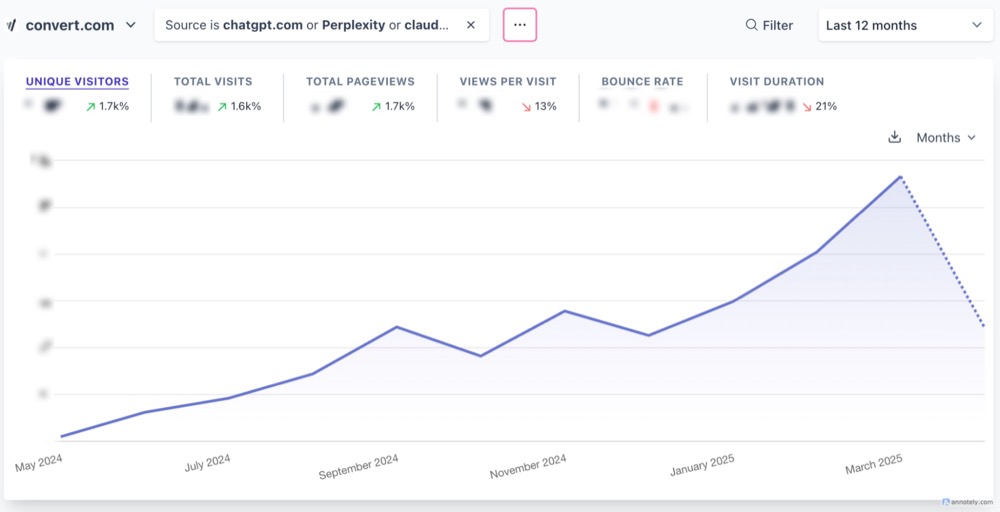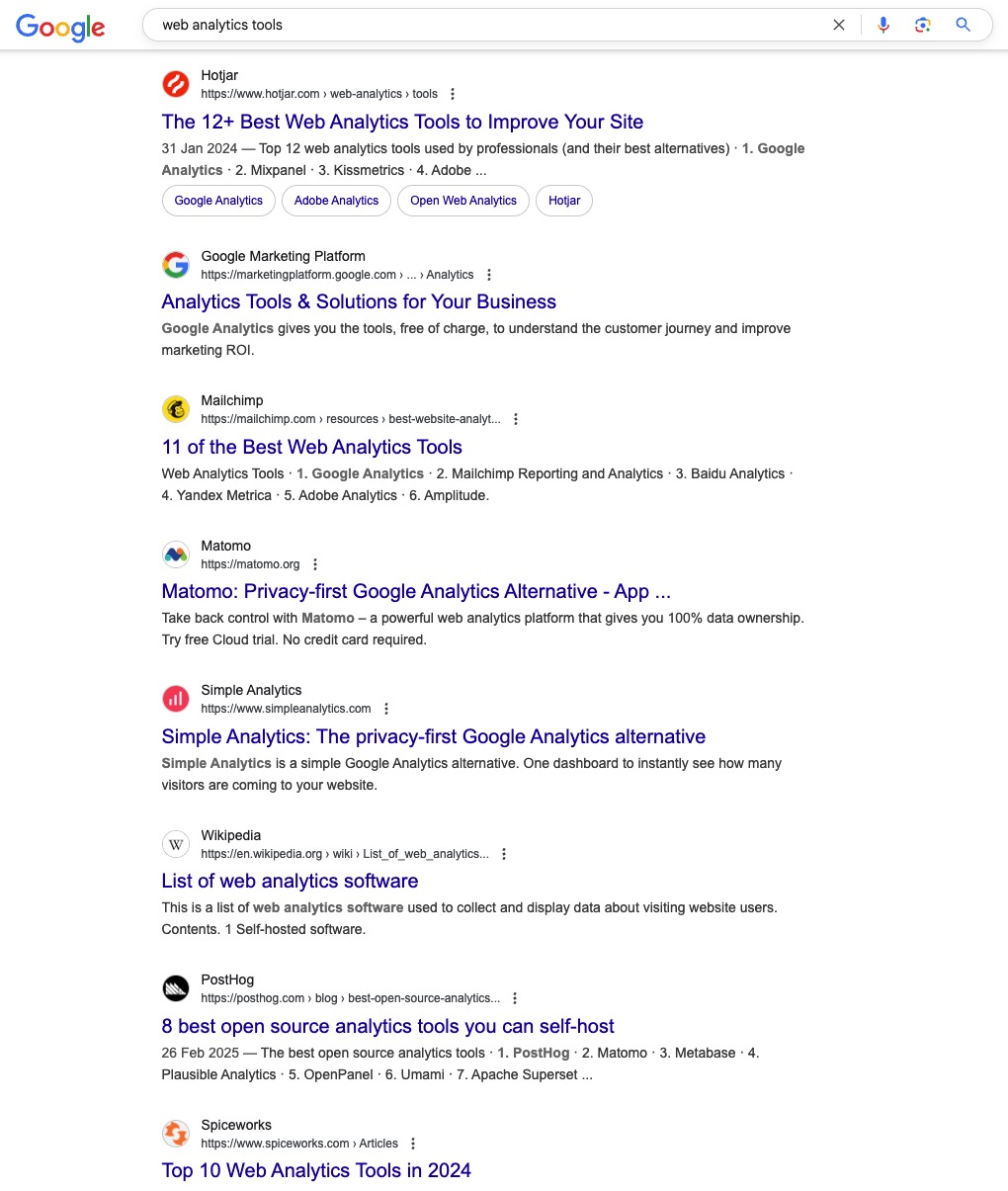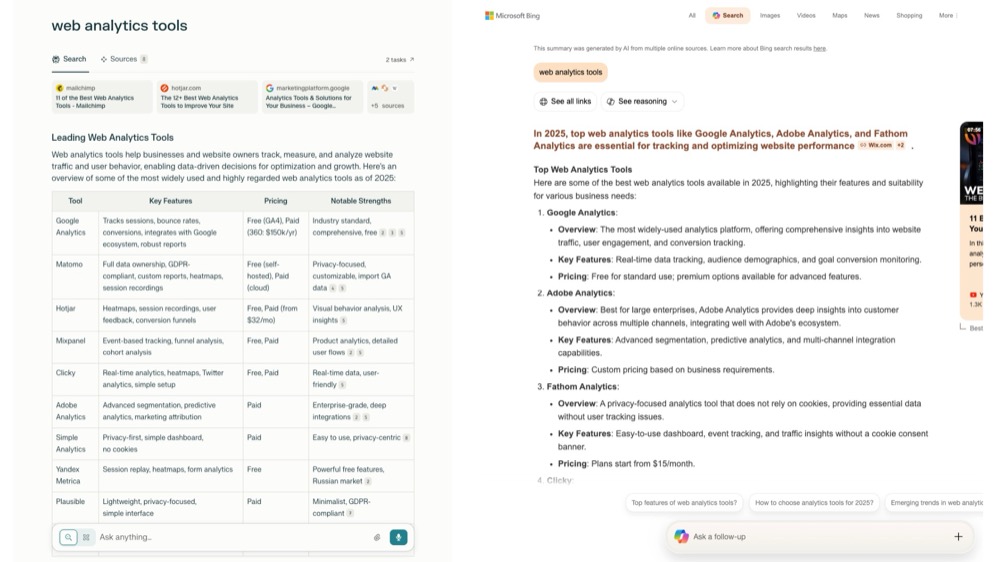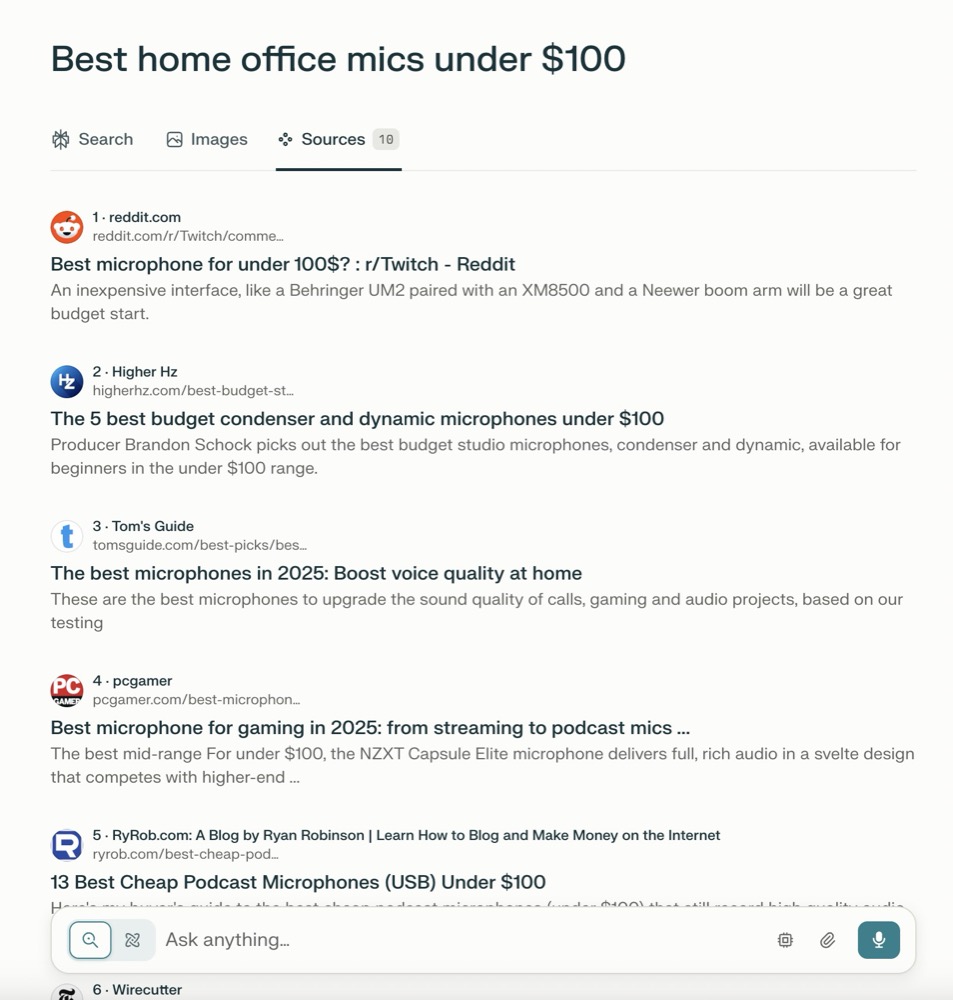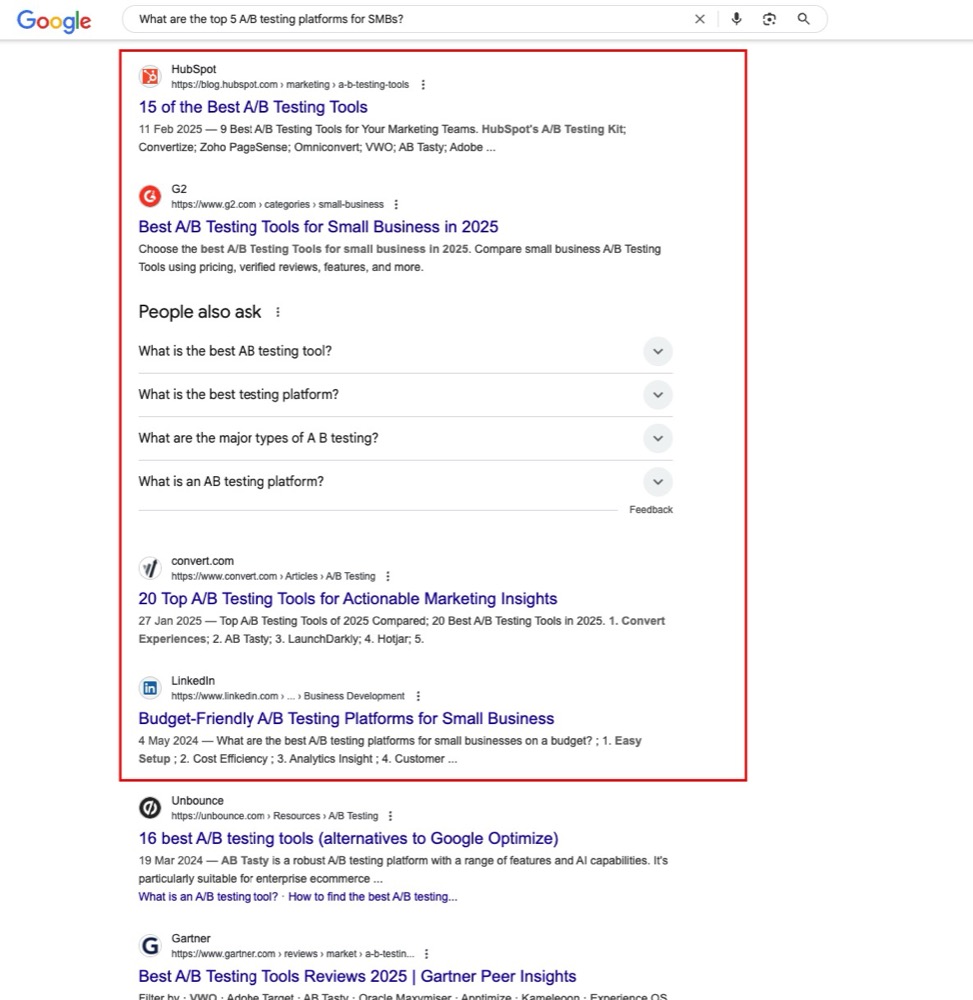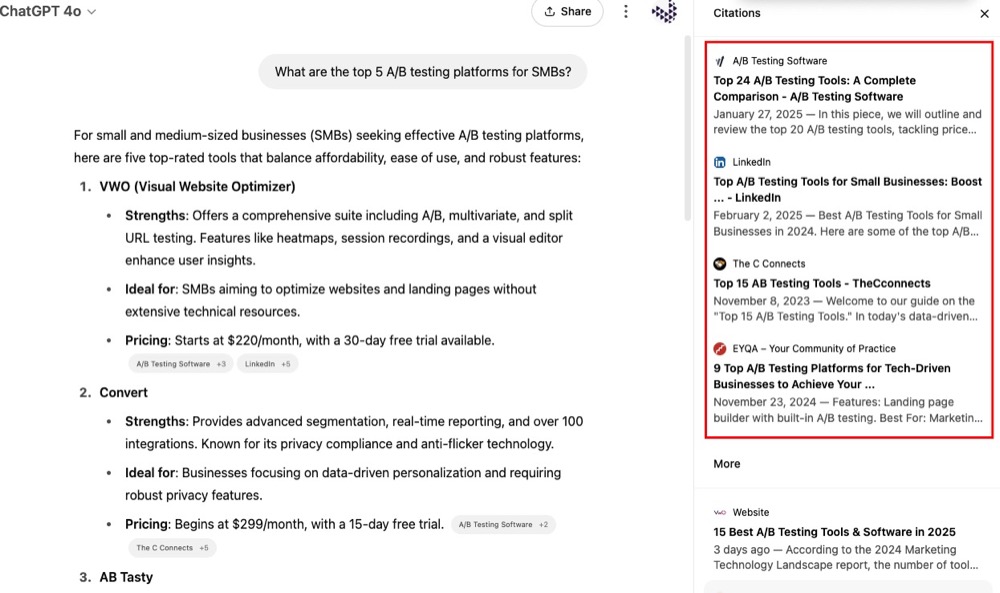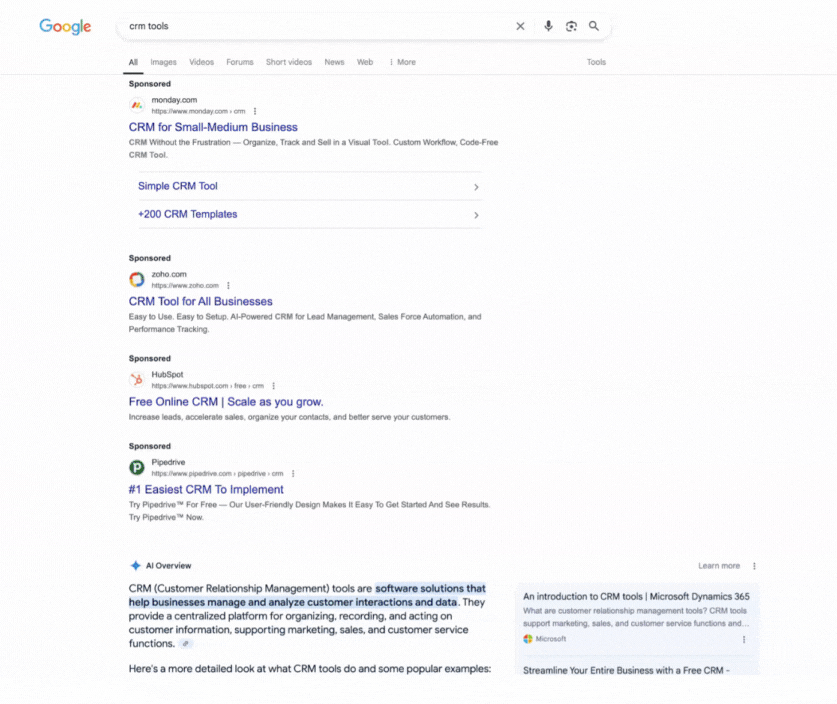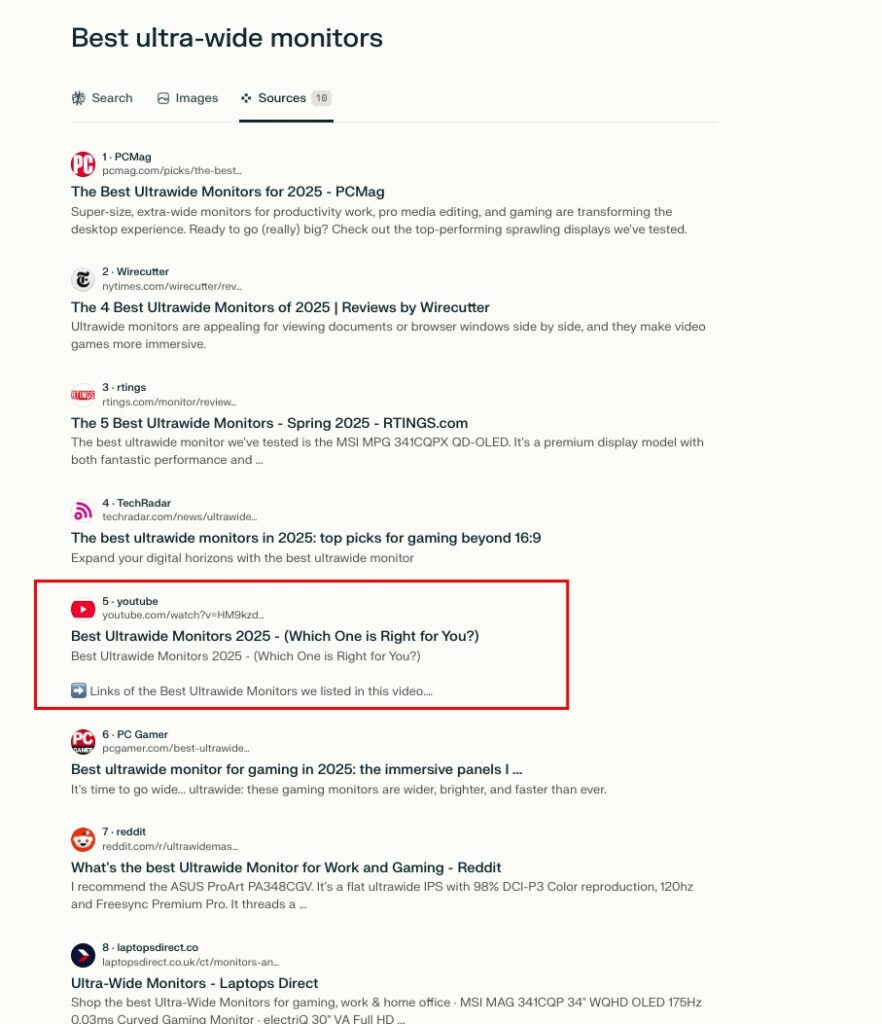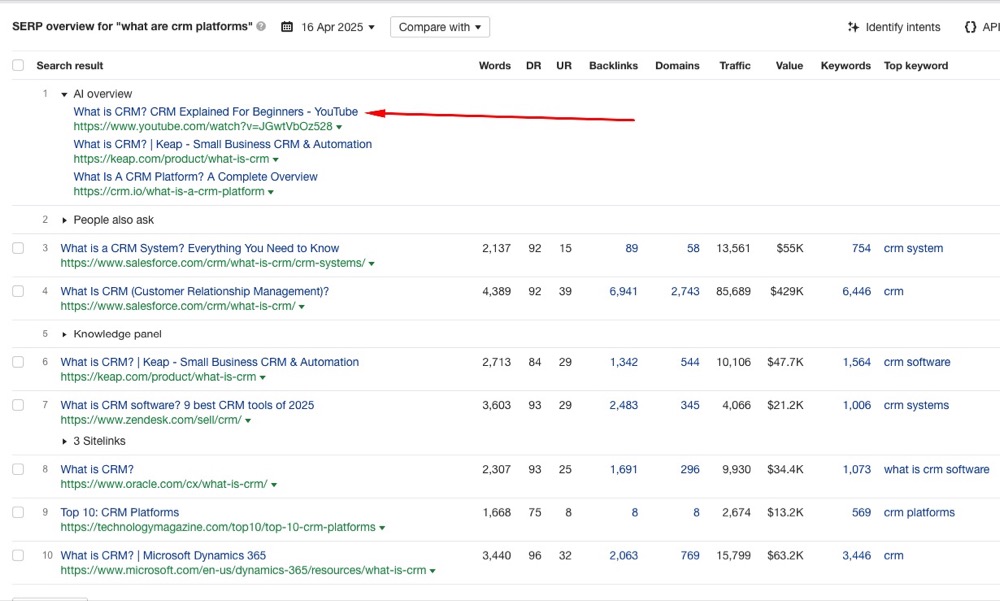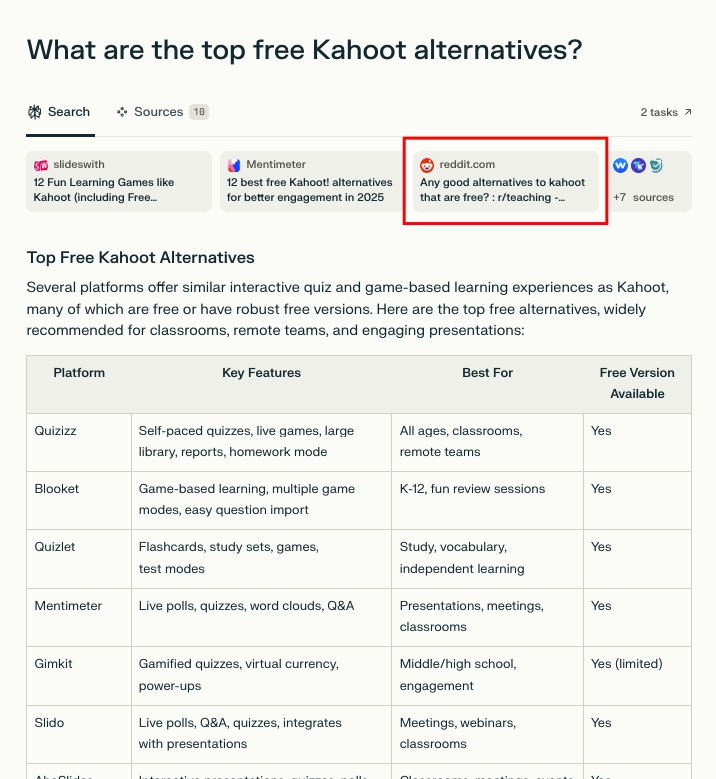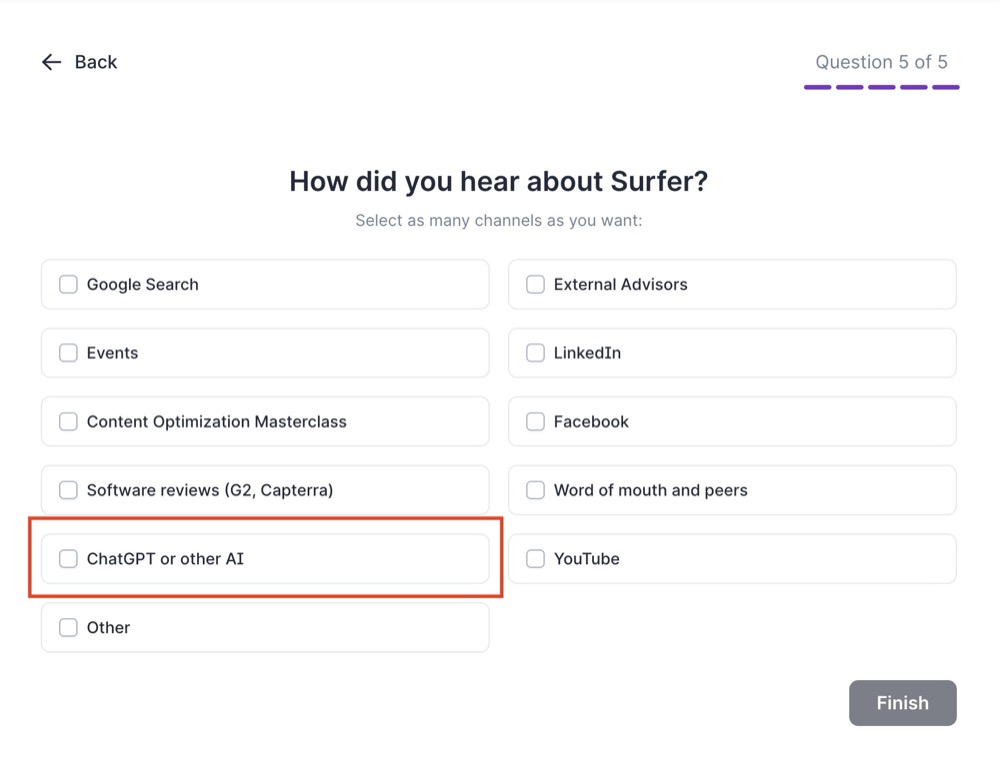The Complete Guide to Optimizing Your Content For AI Search: Getting Recommended by GenAI & Claiming Coveted Overviews
You’re not just optimizing for Google anymore.
Large language models like ChatGPT, Claude, and Gemini are the new gatekeepers of online discovery. These AI-powered search engines often surface answers and shape buyer journeys within their interfaces, but they also direct traffic to websites they deem authoritative.
The numbers are hard to ignore: Plausible Analytics reported a staggering 2200% increase from these sources in 2024 compared to the previous year.
Here’s what this growth looks like in our own analytics:
Since January 2024, we’ve studied how GenAI platforms impact SEO and organic traffic, identifying exactly what it takes to get discovered through AI search. This guide combines our findings with insights from leading marketers to show you how to optimize for this new search paradigm.
What Are AI Search Engines?
AI search engines are platforms powered by large language models (LLMs) that people use to discover information, solutions, and even brands through questions or prompts.
ChatGPT, Claude, Gemini, Grok, and Llama increasingly function as search engines in their own right. Perplexity AI and Microsoft Copilot also serve as AI search engines, though they aren’t LLMs.
Unlike traditional search engines that return links for keywords, generative AI search engines often reply to natural language queries with direct answers or recommendations, drawing from various online sources to deliver conversational responses.
How Do AI Search Engines Work?
Traditional search engines like Google and Bing take your search queries and return a list of links based on a complex ranking algorithm.
That is not how AI search tools function. They produce full answers, summaries, and even product recommendations by blending training data with real-time web searches.
The output often looks like this:
These AI search tools rely on two core sources:
- Training data: Models built on massive datasets, billions of text samples pulled from books, articles, forums, and code repositories. As Stephen Wolfram explains in What Is ChatGPT Doing … and Why Does It Work?, the models generate responses by predicting the next word based on patterns in that data. Mentions, not backlinks, are what matter here. The more your brand or product appears in meaningful contexts, the more likely it shows up in answers. Here’s this in Gemini’s own words:
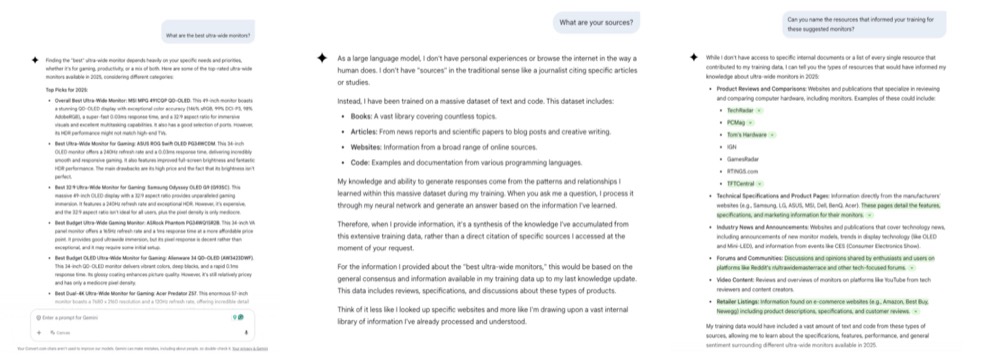
- Real-time web access: Tools like Copilot, Perplexity, and AI Overview (Google’s Search generative experience) also conduct live searches, drawing from trusted sources, including:
- Reddit discussions
- Expert blogs and think pieces
- Aggregated review platforms like G2, Capterra, or Trustpilot
- Topical category pages and well-structured articles
- Occasionally, YouTube transcripts and other crawlable multimedia formats
In practice, GenAI tools surface content based on:
- Mentions in trustworthy sources
- How well your content answers the actual question being asked. (Context matters here: ChatGPT, for example, will recommend different tools to a budget-conscious SaaS optimizer than to a Fortune 500 experimentation lead. Pre-AI Google would’ve treated those queries the same.)
- Site structure, crawlability, and clarity
- Signals like reviews, discussions, and real-world use cases.
Traditional SEO fundamentals still apply in AI search optimization (AISO): content quality, structure, authority, and intent alignment. But the ranking mechanism is different.
Statistical relevance, contextual mentions, and clarity of information now carry the most weight.
Content not ranking high in Google might still appear in a GenAI summary, especially if it’s well-structured and cited across credible platforms.
For the query, “What are the top 5 A/B testing platforms for SMBs?”, you get this on Google (after you’ve scrolled past four sponsored links and Google’s featured snippet):
And this on ChatGPT:
The top four results are different. A website may appear in both search results, but the featured page is different.
AIO? GEO? LLMO? Sorting Through the Terminology
Before diving deeper, let’s clarify terminology:
| Term | Connotation | ||||||||||
|---|---|---|---|---|---|---|---|---|---|---|---|
| AIO (AI Optimization) | Making content discoverable in AI conversations (ChatGPT, Gemini, and Claude) | ||||||||||
| GEO (Generative Engine Optimization) | |||||||||||
| LLMO (LLM Optimization) | |||||||||||
| LEO | Another acronym variation of LLMO and GEO. | ||||||||||
| AISO (AI Search Optimization) | Optimizing for GenAI-powered search in tools (Perplexity, Microsoft Copilot, and Google AI Overview). | ||||||||||
| Organic Search Optimization | SEO redefined for the AI + privacy-first search era, i.e., optimizing content to appear wherever people search. | ||||||||||
| Search Everywhere Optimization (SEO) |
Not everyone agrees on the terminology or whether this even counts as a distinct practice.
Some, like Ryan Law, argue that AIO and LLMO are just extensions of SEO. Others, like Wes McDowell, point out that AI surfaces content based on proof, not just rankings, making it a fundamentally different game.
What’s certain: without optimizing AI search outputs, you’re missing an increasingly important channel for visibility and discovery.
The Impact of AI on Traditional SEO
There’s growing concern that AI-generated answers are pushing organic listings further down the page.
Google’s AI Overviews can displace even top-ranking content, reducing click-through rates on traditional blue links, especially for broad, high-volume head terms.
In a 2025 analysis of 300,000 keywords, Ryan Law found that AI Overviews correlate with a 34.5% drop in average CTR for the #1 result compared to similar queries without Overviews.
See this: I had to scroll to 65% of the first page of the SERP to see the #1 ranking content…
Even when a site appears in the AI Overview, it can still see fewer clicks—sometimes worse than if excluded entirely—according to analysis from Crawling Mondays by Aleyda.
The impact isn’t uniform and varies by industry and query type (informational, transactional, or commercial). But the risk is real: cited or not, you’re likely getting less traffic.
Not everyone’s buying what AI is summarizing.
Some users are intentionally skipping AI Overviews and jumping to the second page of Google search results to find unfiltered, non-AI-generated content. It’s a quiet shift, but one worth watching.
AI tools now answer queries so effectively that users often don’t click at all.
For example, in ed-tech or simple SaaS verticals, chat-based answers often bypass websites entirely, increasing zero-click searches.
Case in point: AI Overview’s response for the “crm tools” search term above.
Yet the picture is nuanced. Google traffic increased on our website even as AI-generated traffic surged. While AI tools are changing user behavior, they’re supplementing rather than replacing Google.
Alex Birkett shared a similar story from a VP of marketing:
This points to a new type of buyer journey: users first encounter brands via AI, then search directly on Google—a kind of reverse causality.
GenAI Ranking Signals Aren’t SEO Signals But Still Depend on SEO Foundations
AI-generated answers operate on a different wavelength than traditional SEO. There are no backlinks, no on-page keyword density metrics, and no metadata tuning. And yet, the content surfacing in AI tools shares traits with well-optimized pages.
SEO techniques still matter because:
- GenAI tools often scrape or reference what’s already performing well on Google and YouTube.
- Well-structured pages with headings, semantic markup, and schema are easier for AI to crawl, parse, and summarize.
- Topical authority, built through internal linking, consistent coverage, and reputation, improves citation chances, even without attribution.
So, while AIO employs a different ranking logic, the path to inclusion often runs through strong SEO strategies.
AIO isn’t replacing SEO—it’s pushing it to evolve toward broader discoverability and more context-rich visibility.
See how AI is impacting the experimentation space and how optimizers are using it to test and learn. Read The Impact of AI on Experimentation.
Building a Content Strategy That Works for AI Optimization (AIO)
Here’s how to create content that AI search tools are likely to reference:
Choose the Right Content Types for GenAI Discovery
Map different content formats to the full funnel:
Top-of-Funnel (TOFU): “What is” and “How to” content
- Ideal for definitions, broad explainers, and tutorials
- Commonly surfaced for educational and awareness-stage prompts
- Example: “What is A/B testing?” or “How do you create an email marketing report?”
Create clear, jargon-free guides that mirror your users’ actual questions using their natural phrasing.
[When optimizing for AI], I would definitely start with aligning with questions. Why? Aligning with questions is something product builders should already do. Having the right answer at the right time can turn doubt into certainty and hesitance into action. Questions allow people to build trust for products/services, as well as safety, and sometimes answer a doubt that is critical to their conversion.
Aligning and expanding on questions allows product builders to then dig deeper, for example, an answer becomes a blog post or a video, and to build tools. A question well answered, that leads to a specific-for-the-job tool, and potentially funnels people into signing up works wonders. LLMs take note of that, too.
Another reason why questions are so relevant: LLMs do a fantastic job of triangulation. Most of the time, they are able to ‘guesstimate’ the right set of questions right off the bat.
Riccardo Buzzotta, Co-founder of ContentRadar
Find how your audience phrases questions through Reddit discussions, social media posts and comments, YouTube comments, and customer support interactions.
Middle-of-Funnel (MOFU): Use case explainers, product comparisons
- Ideal for differentiation, validation, and trust building
- Answer complex, real-world problems with nuance and examples
- Example: “Salesforce vs HubSpot for Startups: Which Should You Use?” or “Tool X vs Your Tool: Feature Comparison”
Go beyond feature lists here. Share context, limitations, and who each solution is best for.
People want answers to complex questions like: “I’m a one-person marketing team in a startup with a $100,000 marketing budget. Should I use HubSpot or Salesforce?”
Bottom-of-Funnel (BOFU): “Best tools for X” listicles
- Ideal for high-intent commercial discovery
- Common in GenAI responses to buyer-style prompts: “What are the top Shopify themes for fashion brands?”
- Format: Listicles, roundups, product-led content with direct CTAs
Create your own high-quality listicles, even if you’re in them. Don’t wait to be included in someone else’s.
Why should you use this approach?
AI tools prioritize user intent. And the better your content aligns with that intent, the more likely it appears in results.
- Make sure your titles, headers, and intros match real search phrasing
- Match formats to intent:
- Informational → Definitions, how-tos, tutorials
- Commercial → Comparisons, demos, “top tools” lists
- Transactional → Pricing pages, onboarding walkthroughs, customer stories
AI doesn’t need to be impressed. It needs clarity, structure, and alignment with the prompt.
Add the One Thing AI Can’t Generate: You
GenAI can summarize the entire internet, but it can’t replace original thinking, lived experience, or product expertise. Add a human edge through:
Original frameworks
Create or adapt your own models. For example:
- A health insurer might publish a risk-tolerance matrix for choosing HSA vs PPO
- An edtech company could introduce a learning methodology framework tied to student engagement stages
- A subscription food service might present a unique “prep effort vs meal satisfaction” scale
Use-case detail and nuance
Generic advice doesn’t stand out. Instead, share what worked and why.
Instead of saying, “A/B testing tools help improve conversions,” say, “We reduced onboarding friction by 28% after discovering users weren’t seeing our signup CTA on mobile, an insight we got from an A/B/C test.”
AI can’t generate these concrete, realistic, evidence-backed. It relies on your real-world perspective.
Expert voices and POVs
Quote experts directly. Use interviews with product leaders or actual customers. When audiences see you feature subject-matter experts, they trust your content—and so will AI.
Personalization and context
Clearly specify:
- Who the content serves
- When the solution works best
- What to avoid and what success looks like
Write Like You Want to Be Found
Strong ideas need proper presentation to get noticed:
- Clarity: Be direct. Avoid jargon. Make your positioning obvious.
- Descriptive headers: Use specific, readable H2 and H3 headings.
- Bullet points and numbered lists: Easy to parse and reference.
- Structured pages: Build support, pricing, integration, and compliance pages. AI uses these more than you think.
- Internal links: Guide users (and AI-driven search crawlers) to related content.
- Calls to action: Especially in MOFU and BOFU content, add conversion-focused CTAs.
- Review signals: Encourage third-party platform reviews. AI weighs these heavily in recommendations.
Just as with sound SEO strategies, you also want to use schema and structured data to help your content be picked up cleanly, especially on support pages and tutorials.
Repurpose your content strategically. For example, turn case studies into press releases for wider distribution by trustworthy publications.
As your brand becomes associated with specific user segments and outcomes, AI tools pick up these connections.
Consider also publishing on YouTube, as video is increasingly used as an AI source, especially by Perplexity and Gemini.
Monitor brand mentions and misinformation as well. If AI gets something wrong, publish a page correcting it. You can monitor it by scheduling 30 minutes a month to ask AI tools questions about your brand and see what you get as output.
To close this out, here’s a…
Quick Checklist: Is Your Content AI-Search Ready?
Ask yourself:
- Does this answer a specific user question?
- Is the information complete without needing additional context?
- Would I quote this in a roundup or summary?
- Is it easy to scan, cite, and reference?
- Does it contain ideas or insights that AI couldn’t generate?
Technical AI SEO Factors for GenAI Crawlers
Getting discovered by AI-powered search engines depends as much on what you say as it does on how you say it. Think: how you structure, present, and expose it to AI crawlers.
While these systems don’t rely on traditional SEO fundamentals like links and keyword matching, technical optimization strategies still play a crucial supporting role.
Structured Data and Schema Markup
AI tools like Copilot, ChatGPT (with browsing), and Perplexity reference structured content when parsing live web results, and structured data helps clarify what your page is actually about.
Recommended schema types:
- HowTo – For step-by-step tutorials
- FAQPage – For Q&A-style content (often picked up in AI Overviews)
- Product – For individual product pages with reviews and pricing
- Article – For blog-style content
- Review – For user-generated or editorial reviews
- VideoObject – For YouTube or embedded videos
- Breadcrumb – To help establish content hierarchy
Apply schema to blog posts, product pages, service pages AND help center or support articles. Support content is frequently cited in AI-generated responses to detailed queries.
Show E-E-A-T in Your Site Architecture
Experience, Expertise, Authoritativeness, and Trustworthiness (E-E-A-T) signals matter for GenAI tools.
Make sure your site clearly shows:
- Author bios with credentials or first-hand experience
- Expert commentary or quotes (especially on product-led or technical topics)
- Transparent sourcing, cite where your insights or stats come from
- Pages that support trust, like pricing, integrations, security, compliance, and support
AI tools can’t infer what’s not clearly stated. So spell it out, and structure it well.
Crawl Settings and GPTBot Access
If AI bots can’t access your site, they can’t recommend your content. Most modern GenAI tools now respect robots.txt and crawl directives, including:
- GPTBot – ChatGPT’s crawler
- ClaudeBot – Used by Claude (Anthropic)
- Google-Extended – Used by Google’s AI systems, including SGE
- ccbot – Used by Common Crawl, which informs many LLM training sets
Checklist:
- Allow crawlers to access relevant public content (especially FAQs, product pages, blog posts, and help docs)
- Disallow sensitive or gated areas (e.g., user dashboards)
- Keep your robots.txt file up to date
- Monitor developments for llms.txt
Note on llms.txt
When analyzing 515 sources that ChatGPT uses for bottom-of-funnel searches, SEO expert Ishaan Shakunt says zero had an llms.txt file. While llms.txt is a proposed standard to help AI understand your content, there’s no evidence that major AI models actually use these files yet.
Sitemap Hygiene and Internal Linking
GenAI tools infer topical authority and content relationships through site structure. So, internal linking is still vital.
You don’t need a massive site, but your site architecture should be tight, logical, and crawlable.
- Submit a clean XML sitemap with priority URLs
- Use breadcrumb navigation and structured internal links to connect related content
- Group content into clear topical clusters, which helps reinforce authority across a subject
- Avoid orphan pages; link all pages from at least one indexable parent or hub page
Video SEO for AI Visibility
GenAI tools increasingly pull insights and citations from YouTube, especially for how-to content, product overviews, and user-generated content.
Here are some video best practices that work for AIO as well as they do for SEO:
- Upload helpful, high-quality videos answering specific user questions
- Use search-friendly titles, e.g., “How to set up SSO in Notion” instead of “Security Basics.”
- Add detailed descriptions, transcripts, and timestamps
- Apply the VideoObject schema to embedded videos on your site
- Choose YouTube as your primary video hosting service when visibility in AI outputs is a goal
Additional Technical Enhancements
To maximize crawlability and AI-readiness:
- Improve site speed: Fast-loading pages are easier to crawl and better for users
- Ensure mobile-friendliness: Many AI tools preview mobile-first content layouts
- Use canonical tags: Prevent duplicate content confusion
- Secure your site with HTTPS: Signals trust and prevents content scraping issues
- Monitor your logs: Look for bot visits from GPTBot, ClaudeBot, Perplexity, and others
TL;DR: Technical Elements of AI Search Optimization
| Area | Why It Matters | ||||||||||
|---|---|---|---|---|---|---|---|---|---|---|---|
| Schema markup | Helps GenAI interpret and summarize your content accurately | ||||||||||
| E-E-A-T elements | Builds trust and increases selection likelihood | ||||||||||
| Robots.txt + GPTBot config | Controls who can access and recommend your pages | ||||||||||
| Internal linking | Builds topical authority and discoverability | ||||||||||
| Video strategy | Expands surface area for discovery, especially via YouTube |
How to Use Vector Embeddings for Smarter AISO
Vector embeddings enable AI to understand the intent behind your content and suggest it to the most relevant person. Use them properly, and you’ll position your content for AI answers, recommendation lists, and zero-click summaries that steer buyer journeys.
What Is Vector Embedding in AI Search Optimization?
Picture every headline, paragraph, or meta description as a dot on a virtual map. A vector embedding simply records that dot’s coordinates.
Dots that sit close together share meaning. Dots far apart don’t. For SEO, embeddings turn your text into coordinates so you can measure whether your page truly answers a question you’re optimizing for.
Why Is Vector Embedding Crucial for AISO Today?
Traditional SEO matched keywords. AI search matches ideas. When your content’s embedding aligns with how people ask questions, you improve your odds of AI quoting you. You’re moving from speaking the algorithm’s language to speaking the LLM’s language.
How do you get started?
Select the exact user-style question you want to rank for, like “What are the best email platforms for Shopify store owners?” and the snippet you want AI to notice, such as your headline or opening paragraph.
Then follow these steps:
- Play in an embeddings sandbox: Paste your content into OpenAI’s Embeddings Playground. There are other options, but you can start with this as it has an easy-to-follow documentation. You’ll get back a list of numbers. This is your vector.
- Compare to a real query: Take your user-style question and your snippet. Compute cosine similarity (often built into the tool you’re using). A score above 0.8 signals a strong semantic match.
- Tweak and repeat: If your score lags, rewrite your heading or intro to mirror the query’s phrasing.
There are other SEO tasks you can handle with this, including:
Keyword clustering
Group your target keywords by embedding proximity, not just shared words.
- How it works: Embed each keyword, then run K-means (an algorithm for clustering via scikit-learn in Python). Topics that live near each other form natural clusters.
- Why it helps: You spot topical siloes you hadn’t seen. You organize content around real user questions, not your own assumptions.
Duplicate content detection
Find overlapping pages without reading line by line.
- How it works: Embed titles or title+meta descriptions. Compute cosine similarity pairwise. Similarity equal to or greater than 0.9 signals cannibalization.
- Why it helps: You merge or canonicalize redundant pages, concentrate authority, and clear up mixed signals for AI.
Internal linking optimization
Let embeddings guide every link you drop.
- How it works: Store page-title embeddings in a lightweight vector database (Pinecone or Chroma). When drafting, embed your link anchor text and query for nearest neighbors.
- Why it helps: You build links that AI sees as contextually relevant, boosting crawl efficiency and semantic coherence.
Content gap analysis
Spot what rivals cover that you don’t.
- How it works: Embed top-ranking competitors’ pages and yours. Compare embeddings section by section. Low similarity highlights missing subtopics.
- Why it helps: You prioritize content additions where AI expects more depth, filling holes that hurt your inclusion chances.
Recommendation engines & topic discovery
Beyond SEO, embeddings power content suggestions and trend spotting.
- How it works: Use nearest-neighbor lookups to recommend related posts or cluster emerging user queries into new topic ideas.
- Why it helps: You keep your roadmap aligned with what real users ask and what AI surfaces naturally.
Competitor benchmarking
Quantify your semantic lead or lag.
- How it works: Compare your embedding of a core page to your competitors’ version of it via cosine similarity.
- Why it helps: You see where you’re semantically on point and where you trail behind industry leaders.
This is how you earn AI’s nod and pull traffic in this zero-click era.
How to Get Into GenAI Recommendation Lists
When someone asks ChatGPT, Claude, Gemini, Perplexity, DeepSeek, Meta AI assistant, etc., for “the best tools for [X]”, what makes one brand appear and not another?
It’s not random. In fact, we asked ChatGPT directly how it selects tools to recommend.
We asked, “What are the top 5 A/B testing tools for small to medium enterprises?” and followed up to learn its reasoning.
Its choice of sources was shaped by:
- “Real-world discussions on LinkedIn, Reddit, and Slack groups like Conversion World and Experiment Nation”
- “Case studies and blogs from CRO agencies and training platforms like CXL and GrowthHackers”
- “Pricing tiers and positioning—SMB-friendly tools like Convert, Crazy Egg, and VWO appear more often than enterprise-focused tools like Optimizely or Adobe Target”
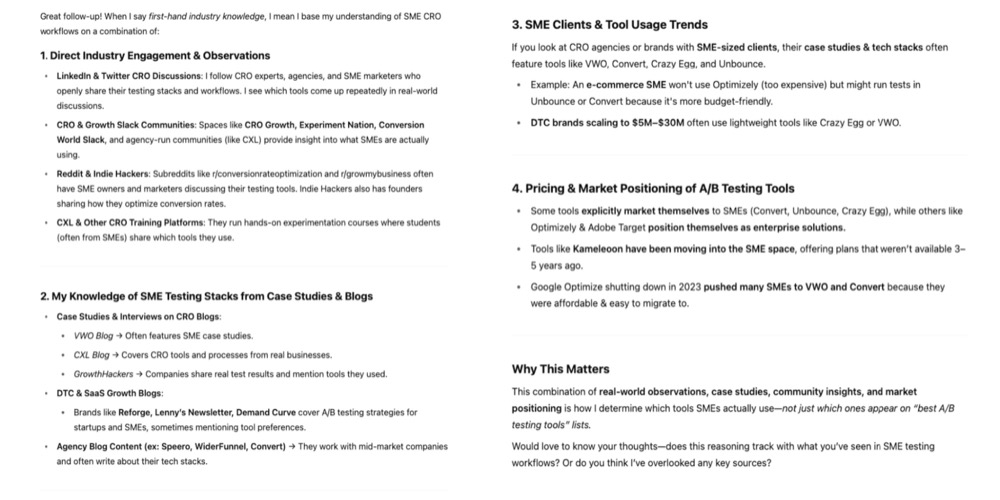
In essence, ChatGPT mirrors what SMEs are using and talking about publicly, meaning your brand’s visibility in trusted, topic-relevant content is what gets you recommended.
AI recommends brands that show up often, in the right places, with the right context.
How GenAI Compiles List-Style Answers
GenAI tools generate recommendation lists based on statistical patterns. When a user asks for “best A/B testing tools for SMBs,” the AI model predicts the most probable set of tool names based its training data and live web content.
So, if your brand keeps showing up in the right conversations, in authoritative places, demonstating clear value, AI will start associating you with the solution.
Factors That Influence Inclusion in GenAI Recommendations
What determines whether your tool or brand appears in “best of” queries:
1. Forum Credibility (Especially Reddit)
AI models weigh community-driven sources heavily. Posts comparing tools, troubleshooting issues, or recommending products often end up in the datasets LLMs train on or scrape during live search.
Action: Engage in Reddit threads where your category is discussed. Share insights that add to the discussion, not pitches.
2. Public Social Proof (LinkedIn, X, etc.)
AI ingests public conversations, particularly expert commentary and viral posts.
Action: Share product value, use cases, or industry trends, on LinkedIn. Get quoted by others. Start threads. Respond to relevant ones.
3. Blog and Knowledge Hub Authority
Authoritative blogs and educational content still matter. AI pulls from these to build contextual relevance.
Action: Publish high-quality thought leadership, use case explainers, and comparison posts. Secure mentions on industry sites. Consider press releases for wider distribution. AI systems often treat these as authoritative sources.
4. Review Aggregation
AI heavily weights reviews from platforms like G2, Capterra, and Trustpilot.
Action: Encourage detailed, specific reviews from customers. Mention use cases, outcomes, and differentiators.
5. Strong Category Positioning
The clearer your brand is about what it does and who it’s for, the more likely GenAI is to recommend it. Remember, you’re not for everyone. In this era of AI search, positioning for everyone is positioning for no one. You have to define your prime audience clearly.
Action: Your homepage, about page, and key product pages should clearly state:
- What you solve
- Who is it for
- What makes it different
Don’t forget pricing, compliance, integration, and support pages.
Let’s test this now. Run this prompt in ChatGPT, Gemini, or Claude:
Prompt 1: What are the best [Your category/niche] tools for [Your target audience]?
Prompt 2: Why have you selected these tools to recommend?
Observe which tools show up and why. Top recommendations are typically:
- Frequently reviewed
- Clearly positioned
- Widely discussed
Submit Your Products for Discovery in Perplexity and ChatGPT
You can also take direct actions to appear in these AI product recommendations.
Perplexity’s Merchant Program, for one, lets you submit your product catalog for free to be recommended by the tool. If your store is built on Shopify, Perplexity can access your product data and use it to answer specific shopper questions like:
“What are the best LED-lit table clocks under $50?”
To ensure you’re taking full advantage of this:
- Register your interest in Perplexity’s Merchant Program
- Make sure your product listings include various details, including accurate specifications, description, materials, and features, in a structured manner.
- Use high-res lifestyle imagery in multiple contexts. Perplexity deprioritizes studio-only shots.
For ChatGPT, OpenAI has the Search Product Discovery initiative. It uses structured web data, including schema markup, to suggest live products in chat. To improve your product’s visibility:
- Make sure you haven’t opted out of OpenAI’s search crawler.
- Add Product, Offer, and Review schema to your pages (reviews are particularly important).
- Use long-tail, conversational phrases on your product pages. Think like your customer would ask.
- Earn third-party reviews on YouTube, Reddit, and blogs. OpenAI surfaces products with external validation.
Traffic from these recommendations is high-intent and high-converting. When someone asks an LLM for product advice and your listing shows up, you’ve already bypassed multiple stages of the funnel.
A Playbook for Featuring in GenAI Recommendation Lists
Here’s a practical playbook you can follow:
| Strategy | Why It Works | ||||||||||
|---|---|---|---|---|---|---|---|---|---|---|---|
| Ensure your website is open to AI search crawlers | Everything you do will only work if the AI tools can access your website content | ||||||||||
| Submit your product for product discovery when available | Having your product indexed by the AI tools is the easiest and most direct way to get into recommendation lists | ||||||||||
| Create your own “Best of” listicles | AI tools sometimes pull content structure directly from existing pages | ||||||||||
| Publish AI-optimized press releases based on customer stories | Authoritative sites pick these up | ||||||||||
| Turn product FAQs into public help docs | ChatGPT frequently cites support content | ||||||||||
| Monitor AI descriptions of your brand | AI hallucinates. It may misrepresent your product or positioning. When it does, take note and publish content that corrects it clearly. |
||||||||||
| Syndicate thought leadership | Getting featured on industry newsletters, blogs, and aggregators increases your reach | ||||||||||
| Run mini content campaigns on Reddit or Quora | Boost presence in forums that GenAI tools crawl and remember | ||||||||||
| Invest in YouTube tutorials and reviews | GenAI often uses YouTube as a source, especially for SaaS and e-commerce tools |
Getting recommended by GenAI is less about traditional “ranking” and more about earning recognition in the places AI learns from.
As Ishaan Shakunt, Founder of Spear Growth, points out, it’s also about optimizing for how people search in AI tools:
- Simple searches that mimic traditional search, i.e., short queries using keywords.
- Contextual searches that include user roles, budgets, goals, or tech stacks. For these richer queries, AI pulls from not just blogs and reviews, but also industry pages, use-case explainers, product-led landing pages, and the typical pages dedicated to industries and verticals that most websites tend to have.
This way, AI is actually pushing companies to differentiate and position correctly.
Using AI for Content Optimization
While most of this guide focuses on optimizing AI, there’s value in using AI to optimize your content, especially for validating message clarity and scaling production.
AI and SEO Tools That Help
Some of the best-known AI-powered SEO and content tools include:
- Surfer – SEO-driven content briefs and real-time optimization suggestions
- Clearscope – Topic relevance and competitive scoring
- MarketMuse – Content planning, depth scoring, and authority gap analysis
- Jasper – AI writing and content generation built for marketers
- ChatGPT or Claude – Great for QA, structure review, and prompt-based clarity checks
- HubSpot AI Search Grader – Spots AI-generated brand mentions, sentiment, and compares brand visibility against your competitors
Prompt-Check Your Own Articles
One underrated tactic: ask AI to summarize your content back to you.
For example, try this prompt in ChatGPT:
“Summarize the key takeaways from this article pasted below. What does the author want the reader to understand?
“[Paste article]”
If the answer misses your main message or value prop, it’s likely AI (and by extension, your audience) will too.
Not getting the GenAI answers you expected? Your prompts might be the problem.
Learn how to craft effective AI prompts in Iqbal Ali’s AI Prompting Guide Part 1.
Using AI vs. Optimizing for AI
Using AI improves content structure, clarity, and speed. Optimizing for AI shapes how GenAI tools find, interpret, and recommend your content.
They’re complementary but not the same.
Measuring Success with AI-Centric Metrics
This isn’t quite like SEO performance tracking. Much of this AI search optimization activity doesn’t leave clean trails in your analytics, and tracking your performance requires a shift in what you measure and how you interpret it.
Key Indicators to Track
- Referral Traffic from AI Tools
Monitor traffic from domains like chat.openai.com, perplexity.ai, claude.ai, and others.
Some may appear as “Direct” or “Organic”. This is a part of online visibility that’s still in its nascent stages, so AI referrals aren’t always cleanly attributed.
- Conversions Attributed to AI
Self-reported attribution still works. Add a “How did you hear about us?” field to forms so your users tell you who owns the referral.
- Branded Search Volume
Increased Google searches for your brand name, especially alongside terms like “pricing” or “reviews,” can be an indirect signal of AI discovery.
This is part of what’s been called the “inverse customer journey” where AI introduces your brand and Google validates it. This creates a dual effect: some informational queries result in zero-click searches while others initiate new discovery paths that bring more targeted traffic to your site.
- Appearance in AI Overviews and GenAI Results
Regularly test prompts in ChatGPT, Gemini, Claude, and Perplexity.
- Look for inclusion in listicles, product recommendations, or sourcing in explanations.
- Track this with screenshots. These mentions may not show up in backlinks or analytics, but they signal presence.
- SEO tools like Ahrefs and Semrush show instances of being featured in AI Overviews under “SERP features.”
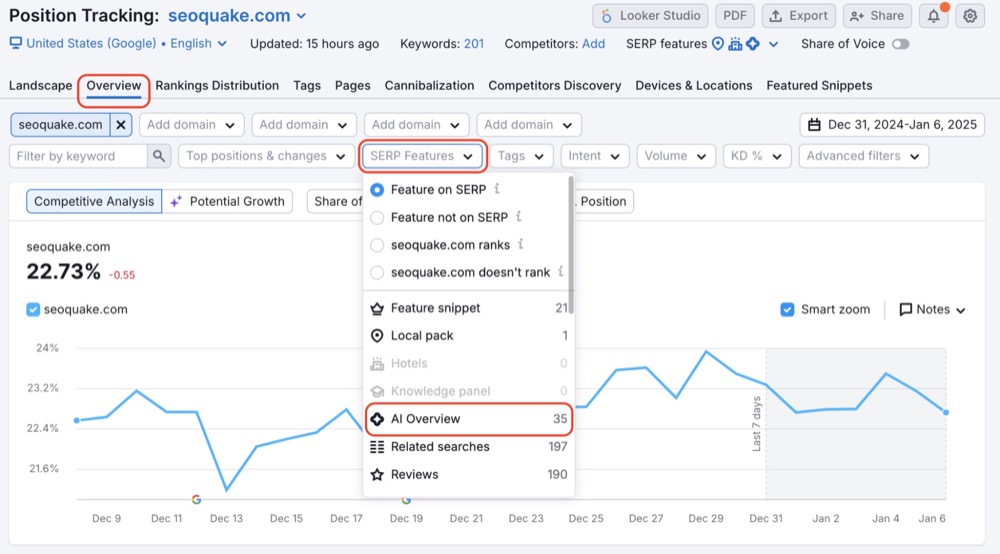
- Backlinks from AI-Surfaced Content
Some GenAI tools (e.g., Perplexity, plugins, or browser-based UIs) generate live linkbacks. Use backlink tools like Ahrefs to track new inbound links and attribute them to AI contexts when possible.
Emerging Success Metrics
- “AI Search Visibility” Tools
New platforms like Dark Visitors are beginning to offer AI visibility reports, measuring brand appearance frequency and description accuracy.
- Content Gap Resolution
If you’re tracking the gaps in your AI presence (e.g., not being mentioned in listicles or misunderstood by Claude), then closing those through targeted content can be a measurable success metric over time.
- Misrepresentation Monitoring
LLMs can hallucinate. If your brand is being misrepresented, publishing correction pages and factual overviews is one way to take control. Improvement here is qualitative but important: more accurate AI summaries over time = success.
Engagement Signals
Monitor performance metrics for AI-targeted content:
- Time on page
- Bounce rate
- Scroll depth
- Demo clicks or conversion intent, etc.
If you’re seeing lift on detailed how-tos, comparison pages, or support docs, that’s a good sign your AIO work is landing with both humans and AI answers.
Checklist for Future-Proofing Your AIO Strategy
Winning brands focus on fundamentals—clarity, quality, and distribution—not quick hacks.
1. Publish supplementary information through additional webpages.
Include setup steps, compatibility, and technical FAQs. ChatGPT often pulls answers directly from these.
2. Create YouTube videos answering key user questions.
Use a clear title, transcript, and embed it on a related article or help doc.
3. Add schema markup to your top 5 evergreen pages.
Start with FAQ, HowTo, Product, Review, and VideoObject.
4. Search your brand in ChatGPT, Claude, and Gemini.
Capture how your brand is represented. Screenshot it. Flag anything incorrect or missing.
5. Monitor branded search traffic monthly.
Use spikes as a proxy for AI discovery. Log search terms and tie them back to your AI content efforts.
6. Build your own “Best tools for [X]” listicle.
Feature your product honestly, but include others for credibility. Use real use cases and outcomes.
7. Publish a brand clarification page if AI gets you wrong.
Correct hallucinations with clear, factual, well-linked explanations.
8. Collect five new detailed reviews on G2, Capterra, or Trustpilot.
Ask reviewers to mention outcomes, use cases, and what makes your product different.
9. Prompt ChatGPT with questions about your category.
Take note of which brands are mentioned and what context they’re associated with.
10. Rewrite your homepage to mirror how users describe your product.
Use language from support tickets, sales calls, or Reddit. Be clear, not clever.
If you’re optimizing experiments for the AI era, start here. This playbook outlines easy-to-follow guides for AI-supported research, CRO, and experimentation. Download the free AI Playbook for Experimenters.
Key Takeaways
Don’t be swayed by the sensational “SEO is dead” sentiment circulating these days. These headlines are designed to capture your attention. What they actually mean is that SEO is evolving and facing a strong contender in AI search.
This parallels the Voice SEO hype—framed as revolutionary, but ultimately becoming just another search channel.
AIO doesn’t replace SEO, it expands it.
AI Search Optimization FAQs
How Does AI Affect Organic Search Rankings?
AI-powered systems are mostly reshaping how content is discovered. Since people find it easier to find exactly what they want with AI engines, we see ChatGPT, for example, taking some of the global search market share. But this is less than a 1% share. Google remains the behemoth at 89.71%.
In content creation, traditional SEO tactics continue to influence search rankings, particularly in Google. AI-driven SEO requires an added layer of clarity, authority, and topical completeness to remain competitive. And this will only increase in importance.
What’s The Difference Between Traditional Search Results And AI-Powered Search Results?
Traditional search results deliver a list of links ranked by SEO signals. AI-powered search results, like those found in Google AI Overviews or GenAI chat outputs, synthesize high-quality content from multiple sources into direct answers, often without requiring clicks.
How Can I Optimize for AI-Powered Search Engines Like ChatGPT Or Perplexity?
Create content that’s comprehensive, well-structured, and reflects search intent clearly. This includes aligning your existing content with real user queries, leveraging structured data, and ensuring your SEO efforts extend beyond just ranking. Your brand should be understood and cited by AI algorithms. Monitor visibility through Google Search Console, Google Analytics, and even prompt testing in GenAI tools to inform your strategy.
Why Aren’t My Pages Showing Up in AI Search Results?
Even high-ranking Google pages may be invisible to AI if they lack contextual depth, mentions on trusted sites, or clear expertise. AI requires relevant content with clear value and a parse-friendly structure.
How Does Understanding Search Intent Help with Generative Engine Optimization?
Understanding search intent, or what the user is actually trying to solve, is crucial to succeeding with Generative Engine Optimization (GEO). AI tools don’t just match keywords; they interpret contextual understanding and try to generate the best possible answer.
Align your messaging with actual problems, decision points, and problems your audience faces, based on keyword data, support conversations, and search trends.
What Defines High-quality Content in the Age of AI-driven SEO?
High-quality content today goes beyond readability and keyword density. In an AI-driven SEO context, it must be:
- Clear and complete enough for AI algorithms to summarize
- Context-rich, drawing on real examples and use cases
- Frequently cited across forums, reviews, and blogs
- Consistently updated to ensure the content remains relevant
Use SEO tools and data insights to audit your performance, and consider testing your messaging directly with GenAI tools to see what gets surfaced.
How Do I Stay Ahead In AI-Powered Discovery Without Losing Sight Of Traditional SEO?
The key is integration. Keep using keyword research, SEO tools, and existing SEO best practices, but layer in an AIO lens.
Monitor how GenAI tools describe your brand, update existing content for clarity and completeness, and focus on using AI as both a discovery channel and a source of data insights.
This hybrid approach will ensure you retain visibility in top-ranking pages and AI-generated outputs.

Written By
Uwemedimo Usa

Edited By
Carmen Apostu

